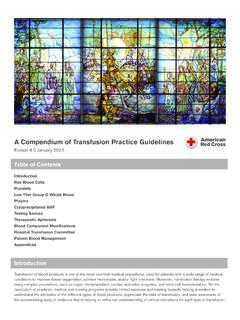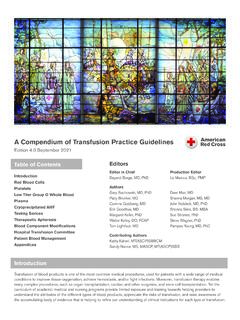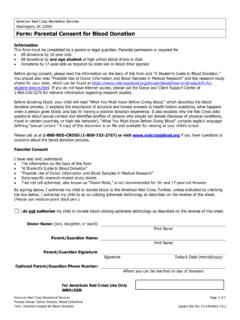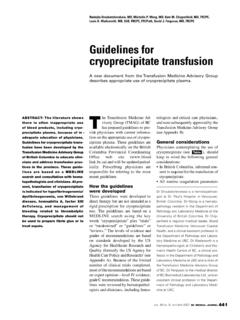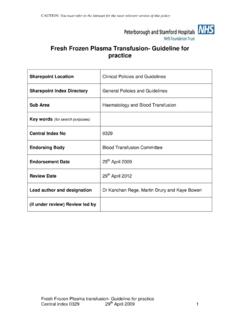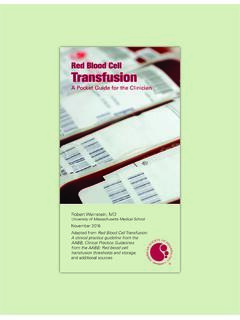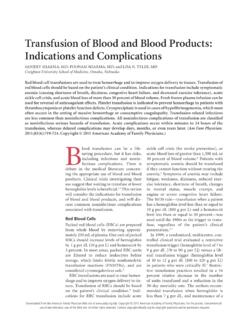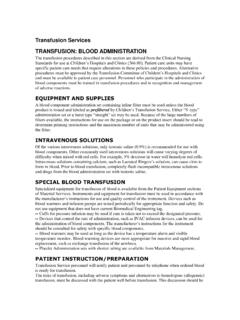Transcription of Recommended Strategies for Managing Blood Product …
1 The American Red Cross strives to maintain Blood inventories to meet hospital and patient needs. However, periodic shortages are inevitable. Although the Red Cross aims to prevent shortages, we must also prepare to manage them and minimize their impact. To aid our hospitals during these challenges, the Red Cross has developed a compilation of general Strategies for Managing Blood Product shortages including in massive transfusion situations. These recommendations were based on Red Cross medical director and hospital input and can be employed, as needed, by your institution. Any or all these measures can be taken at your discretion in conjunction with your hospital s policies and considering the treatment needs of particular patients.
2 We hope that you will find this helpful as you manage your Blood supply. This document may also be useful to you to meet the requirements of the AABB Standards to develop transfusion service guidelines to manage Blood component shortages. However, nothing in this document should replace the clinician s judgment about the patient care. Routine Review actions 1. Log in at When Product supply status is purple, red or yellow, or if your hospital is notified that standing and ad hoc orders will not be filled as planned: a) Review and determine the minimum required inventory held at your hospital. The Blood supply cannot support stocking orders at this time. Carefully monitor your inventory to minimize Product expiration. b) Place short-dated Product up front so staff can easily access them.
3 Establish an outdate target of zero. c) Readily move products between hospitals in your community to limit outdating. d) Prioritize with the operating room, emergency department, and floor staff to avoid wastage due to temperature limits/time out of the Blood bank. 2. Ensure that elective surgeries which have any possibility of utilizing Blood have a type and screen performed before the scheduled procedure. 3. Actively promote Blood donations within your hospital and your community. 4. Implement Blood inventory status updates or dashboard for key hospital staff, including medical staff, quality, nursing leadership and administration to communicate the degree (mild, moderate or severe) of shortage you project and to emphasize the importance of vigilance. 5. Contact your Red Cross Medical Director as needed to discuss and review any necessary actions and information on local supply challenges.
4 Recommended Strategies for Managing Blood Product Shortages Blood Shortage Strategies December 2021 Blood Shortage Strategies December 2021 Mild Shortage: Hospital Inventory is 25% lower than anticipated Red Blood Cells/Platelets: Ensure restrictive transfusion triggers are followed for RBCs (Hgb 7 mg/dL) and platelet transfusions (Platelet count <10 x 103 per L for hypoproliferative thrombocytopenia, 50 x 103 per L for major surgeries, and 100 x 103 per L for neurological surgeries), Plasma (INR >2). Group O products are the most critical RBC Product . Ensure type-specific Blood is issued whenever possible for trauma and massive transfusions. Communicate with emergency department and operating room staff that type and screens must be sent as quickly as possible for a patient without a current type and screen.
5 Notify surgical staff and medical leadership that Group O Blood will not be available for emergency release for elective cases without a current type and screen. Notify adult and pediatric oncology leadership that outpatient platelet and RBC transfusions be limited to one unit whenever possible. Do not screen Rh-negative inventory (especially O negative) for CEK-negative units. Transfuse one unit at a time and re-check lab parameters between transfusions whenever feasible. Limit ability for medical staff to order more than one Product at a time except for instances of active bleeding. Increase flexibility when placing Product orders from your Blood provider. Accept PAS platelets, Pathogen Reduced (PR) platelets, and Large Volume Delayed Sampling (LVDS) platelets interchangeably.
6 Remove restriction on issue of ABO/Rh matched platelets for most patients. Particularly for PAS and PR platelets in which ABO isohemagglutinins are significantly reduced. RhIg ( Rhogam or Rhophylac) may be administered to non-immunocompromised Rh-negative patients of childbearing potential who receive Rh positive platelet transfusions, although many centers forego this due to the extremely low incidence of alloimmunization from such exposure. Reserve ABO-compatible platelet transfusions for stem cell transplant recipients and pediatric patients with small Blood volume. Plasma/Cryoprecipitate: Reduce plasma use by maximizing the use of albumin as a replacement fluid for therapeutic apheresis procedures except where contraindicated. Blood Shortage Strategies December 2021 Moderate Shortage: Hospital Inventory is 50% lower than anticipated General Actions: Issue Blood to the floor only when a transfusion is imminent (patient is in room, vascular access is established, etc.)
7 Implement a prospective review of all Blood Product ordering before release from the Blood bank. Specifically, verify that transfusion is expected within the next 8 hours. Cancel orders when the clinical need has changed. Red Blood Cells: Provide antigen-negative RBC only to patients who have formed an antibody. Postpone prophylactic red cell exchanges unless the hemoglobin S level is close to 30% (to prevent stroke) or 40-50% (to prevent other complications). In cases of significant anemia without an elevated HbS level, only a simple transfusion is required. Limit use of CEK-negative units to sickle cell patients who are alloimmunized to at least one clinically significant alloantibody. Reschedule sickle cell patients based on (actual or anticipated) pre-procedure HbS (<30% for stroke and <40% for non-stroke).
8 Alternatively consider: Modified exchange procedures in lieu of full exchange procedures or a simple transfusion in lieu of an exchange transfusion . Use CEK-negative prophylactically only for females of childbearing potential. Consider changing pediatric transfusion policies to accept AS1 or AS3 if not already implemented. Reevaluate CMV-negative guidelines to provide CMV-safe for most transfusions. Canada s National Policy on CMV ensures CMV-negative for only in utero transfusions and requires CMV-safe for all other transfusions. Platelets: Remove restrictions on ABO-incompatible platelet transfusions for stem cell transplant recipients and pediatric patients with small Blood volume. Consider volume reduction, if necessary. Plasma: Restrict use of Group AB plasma to patients of this Blood type; follow hospital procedures/policies in transfusing Group A plasma as an alternative when patient Blood type is undetermined.
9 Use Group A plasma for emergent transfusions and massive transfusions. Cryoprecipitate: Reduce pool size (from 10 to 8 if hospital is pooling and issue one unit instead of two of pre- pooled cryoprecipitate). Blood Shortage Strategies December 2021 Severe Shortage: Hospital Inventory is 75% lower than anticipated Red Blood Cells/Platelets: When possible, split platelet units into smaller doses, which is an evidence-based, practice-based method for adult oncology inpatients based on the PLADO study (Slichter et al. N Engl J Med 2010;362:600-613). Avoid prophylactic transfusion of thrombocytopenic patients not actively bleeding, so platelets are available for actively bleeding patients needing therapeutic platelet transfusion . Consider using platelet counts of 5 x 103 per L as the trigger for prophylactic platelet transfusions rather than 10 x 103 per L Plasma/Cryoprecipitate: Evaluate a more permissive policy for Prothrombin Complex Concentrates ( , Kcentra).
10 Consider using tranexamic acid when appropriate. Implement off-label use of fibrinogen concentrate (RiaSTAP or other FDA approved similar products) to reduce the use of cryoprecipitate. Managing massive transfusion Protocols in times of Blood shortage Due to the relatively high utilization of universal Blood components and risk of Product wastage during massive transfusion protocol (MTP) activations, we encourage trauma hospitals to periodically evaluate their MTP practices, particularly during Blood shortages. Ideally, these evaluations will engage stakeholders in both the Trauma Service and the transfusion Service, resulting in a partnership with shared outcome measures. We recognize that each hospital exists in a highly specialized practice environment, and that there is not a universal approach that can be deployed to yield optimal results.
